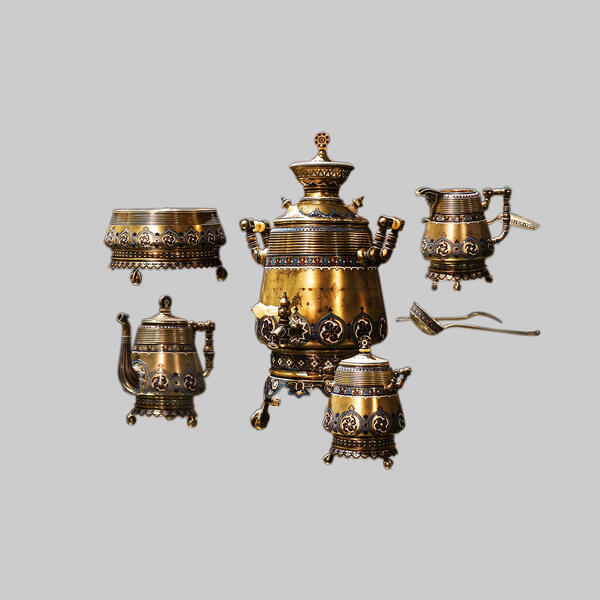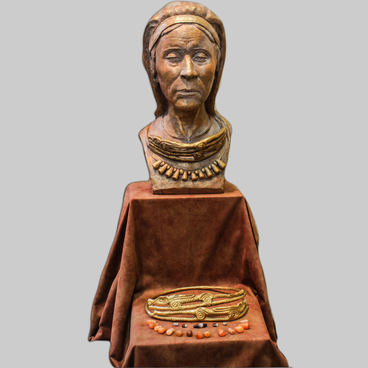This tea and coffee set of ten silver items was produced by Ivan Khlebnikov’s Moscow Jewelry Factory. It was famous throughout the Russian Empire: its creations still adorn the cathedrals of the Moscow KrEmlin, as well as palaces and showcases of many Russian and foreign museums and private collections.
The Russian style tea set was transferred to the State Museum of the South Ural History in 2013. It consists of a samovar, a coffee pot, a teapot, a sugar bowl, a cream pitcher, a candy dish, sugar tongs, a fork, a spoon, and a strainer. The items are all made in the same style and have different finishes: mother of pearl, polychrome champlevé enamel, chasing, granulation, carving. The set is made of gilded 84 zolotnIk silver (875 silver). All items feature the factory’s stamp that confirms the high quality of the set.
Khlebnikov’s factory was famous for its signature “Russian style” with the traditional forms of Old Russian cups, bowls, and loving cups, images of tower chambers and firebirds, and scenes from peasant life and Russian folk tales. This style perfectly complemented the versatile, delicate, and fluid modern elements. The craftsmen could give silver the texture of wood, fabric, or fur.
This set is not the only museum exhibit made at Ivan Khlebnikov’s factory. The factory’s other creations are displayed in the collection Precious Metals and Gem Stones.
Ivan Khlebnikov owned a jewelry workshop in Moscow In the 1850s. By the 1870s, it had grown into a whole factory of diamond, gold, and silver jewelry. The factory enlisted the services of famous artists. It’s products — cutlery, snuff boxes, writing instruments, cigarette cases, small chests — were notable for their variety of decor and high quality finishes. Ivan Khlebnikov’s factory held the prestigious title of an imperial court supplier and had the right to put the image of the national emblem on its products. The trading company I.P. Khlebnikov, Sons and Co. was set up in 1880. The factory closed in the summer of 1917, after which the Bolsheviks nationalized it and transformed it into the Moscow Platinum Factory in 1918.
The Russian style tea set was transferred to the State Museum of the South Ural History in 2013. It consists of a samovar, a coffee pot, a teapot, a sugar bowl, a cream pitcher, a candy dish, sugar tongs, a fork, a spoon, and a strainer. The items are all made in the same style and have different finishes: mother of pearl, polychrome champlevé enamel, chasing, granulation, carving. The set is made of gilded 84 zolotnIk silver (875 silver). All items feature the factory’s stamp that confirms the high quality of the set.
Khlebnikov’s factory was famous for its signature “Russian style” with the traditional forms of Old Russian cups, bowls, and loving cups, images of tower chambers and firebirds, and scenes from peasant life and Russian folk tales. This style perfectly complemented the versatile, delicate, and fluid modern elements. The craftsmen could give silver the texture of wood, fabric, or fur.
This set is not the only museum exhibit made at Ivan Khlebnikov’s factory. The factory’s other creations are displayed in the collection Precious Metals and Gem Stones.
Ivan Khlebnikov owned a jewelry workshop in Moscow In the 1850s. By the 1870s, it had grown into a whole factory of diamond, gold, and silver jewelry. The factory enlisted the services of famous artists. It’s products — cutlery, snuff boxes, writing instruments, cigarette cases, small chests — were notable for their variety of decor and high quality finishes. Ivan Khlebnikov’s factory held the prestigious title of an imperial court supplier and had the right to put the image of the national emblem on its products. The trading company I.P. Khlebnikov, Sons and Co. was set up in 1880. The factory closed in the summer of 1917, after which the Bolsheviks nationalized it and transformed it into the Moscow Platinum Factory in 1918.



